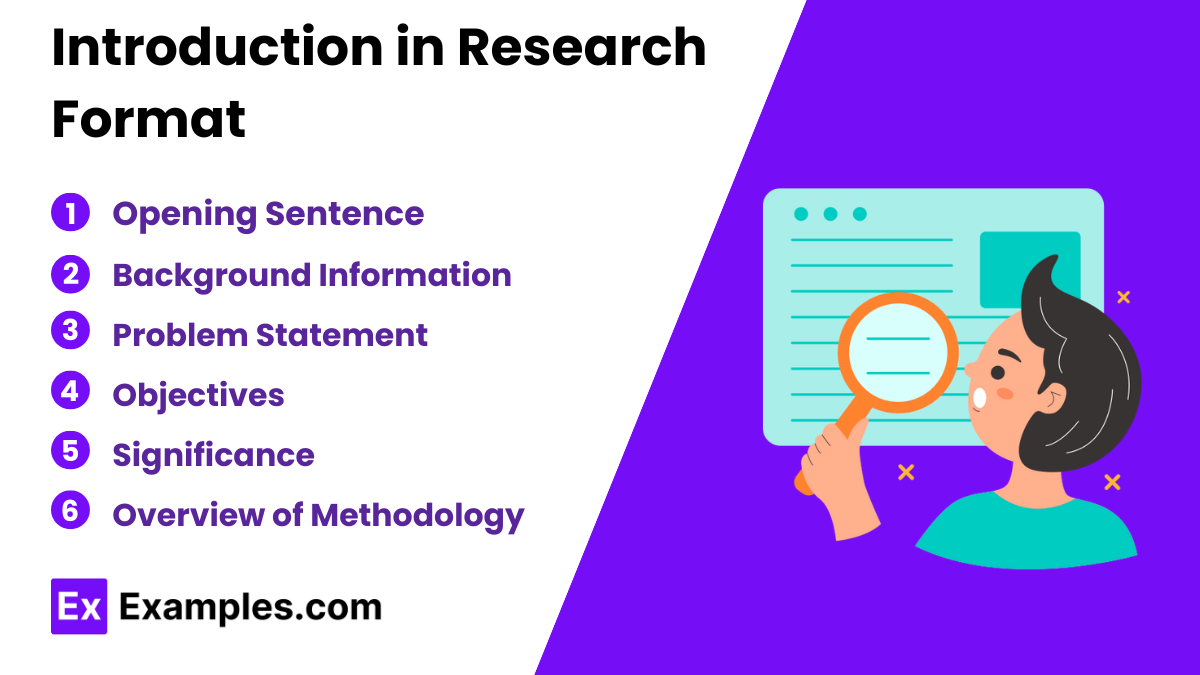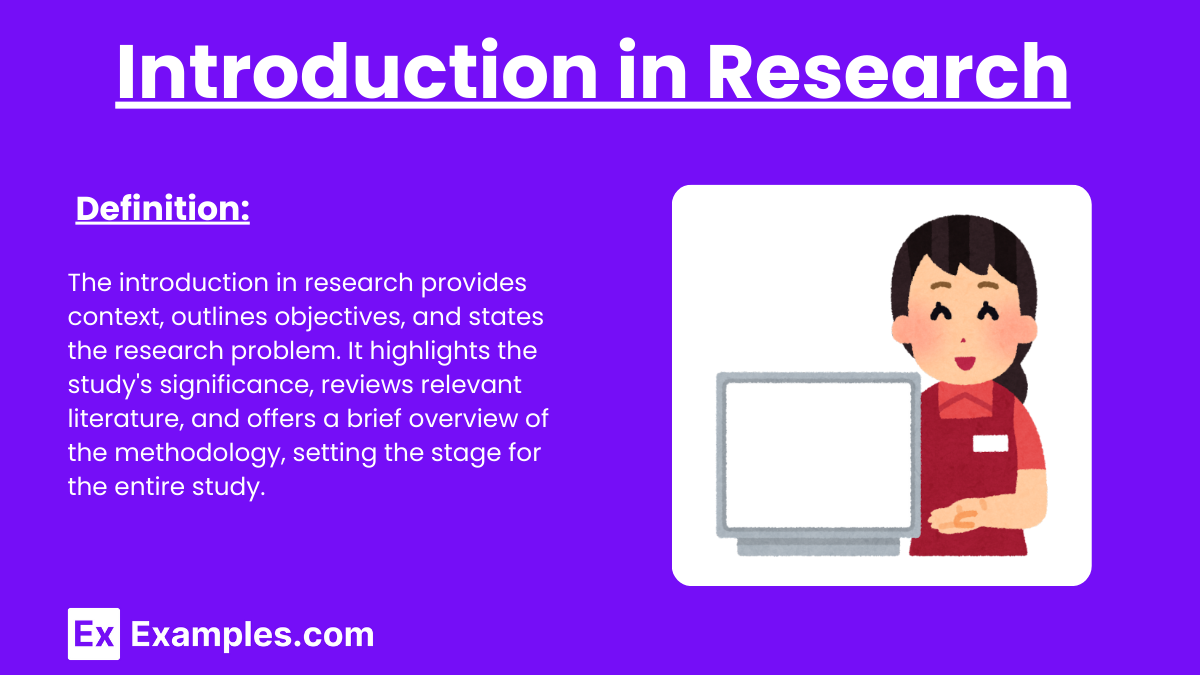16+Examples, Introduction in Research Examples
Introduction in research serves as a critical component, setting the stage for the entire study. It provides context, explains the significance of the research, and outlines the objectives. For example, a self-introduction essay in the introduction can help personalize the research, making it relatable. This initial section is crucial for engaging readers and establishing the foundation for the subsequent analysis and discussion. Effective introductions ensure clarity and focus, guiding the reader through the research journey.
What is Introduction in Research
Introduction in research is the initial section that provides context, states the research problem, outlines objectives, and highlights the study’s significance. It engages readers, sets the stage for the research, and guides the direction of the entire study.
Introduction in Research Format

- Opening Sentence:
- Engage the reader with a broad context or compelling hook.
- Background Information:
- Provide relevant details to set the stage for the research.
- Problem Statement:
- Clearly define the specific research problem or question.
- Objectives:
- Outline the main goals and aims of the research.
- Significance:
- Explain the importance and potential impact of the study.
- Overview of Methodology:
- Briefly describe the research methods and approach used.
Introduction in Research Examples
Research Introductions Across Various Fields
- Impact of Climate Change on Coastal Ecosystems
- Introduction in research serves as the opening passage, setting the stage for an exploration of the impact of climate change on coastal ecosystems. This study aims to understand the specific changes in marine biodiversity due to rising sea levels and temperatures.
- Effects of Social Media on Adolescent Mental Health
- In this research, we examine the effects of social media on adolescent mental health. By analyzing various psychological factors, we aim to identify patterns and suggest strategies for healthier online interactions among teenagers.
- Relationship Between Economic Policies and Unemployment Rates
- The research introduction delves into the relationship between economic policies and unemployment rates. This study investigates how different fiscal approaches have influenced job markets in the past decade, providing insights for future policy-making.
- Role of Renewable Energy in Reducing Carbon Emissions
- This research investigates the role of renewable energy in reducing carbon emissions. The introduction outlines the current dependency on fossil fuels and the potential benefits of transitioning to sustainable energy sources.
- Advancements in Artificial Intelligence in Healthcare
- Our study explores the advancements in artificial intelligence and its applications in healthcare. The introduction discusses the growing reliance on AI for diagnostics and treatment, emphasizing the need for further research in this field.
- Historical Significance of the Silk Road in Cultural Exchanges
- The focus of this research is the historical significance of the Silk Road in cultural exchanges between East and West. The introduction highlights key periods of interaction and the lasting impact on global trade and culture.
- Effectiveness of Online Learning Platforms in Higher Education
- In this study, we assess the effectiveness of online learning platforms in higher education. The introduction reviews the shift from traditional classrooms to digital environments, addressing both the benefits and challenges faced by students and educators.
- Psychological Effects of Childhood Trauma on Adult Behavior
- This research examines the psychological effects of childhood trauma on adult behavior. The introduction provides an overview of various types of trauma and their long-term consequences, setting the foundation for a detailed analysis.
- Consumer Behavior in the Digital Age
- Our study aims to understand consumer behavior in the digital age. The introduction outlines the evolution of marketing strategies and their influence on purchasing decisions, particularly in the context of e-commerce.
- Genetic Factors in Common Hereditary Diseases
- This research delves into the genetic factors contributing to common hereditary diseases. The introduction discusses recent breakthroughs in genomics and their implications for personalized medicine and preventative care.
- Impact of Urbanization on Wildlife Habitats
- The focus of this study is the impact of urbanization on wildlife habitats. The introduction presents an overview of urban expansion and its detrimental effects on biodiversity, underscoring the need for sustainable development practices.
- Relationship Between Diet and Mental Health
- In this research, we explore the relationship between diet and mental health. The introduction highlights the growing evidence linking nutritional choices to psychological well-being, advocating for a holistic approach to mental health care.
- Influence of Political Rhetoric on Public Opinion
- This study examines the influence of political rhetoric on public opinion. The introduction reviews historical and contemporary examples, aiming to understand how leaders shape societal beliefs and attitudes through their speeches.
- Effects of Sleep Deprivation on Cognitive Performance
- Our research investigates the effects of sleep deprivation on cognitive performance. The introduction discusses the prevalence of sleep disorders and their impact on various cognitive functions, such as memory and decision-making.
- Challenges and Opportunities of Remote Work
- This research focuses on the challenges and opportunities of remote work. The introduction addresses the recent shift towards telecommuting, analyzing its effects on productivity, work-life balance, and employee satisfaction.
- Role of Technology in Education Reform
- In this study, we assess the role of technology in education reform. The introduction reviews current educational technologies and their potential to enhance learning experiences and outcomes in K-12 and higher education settings.
- Environmental Impact of Single-Use Plastics
- The aim of this research is to evaluate the environmental impact of single-use plastics. The introduction outlines the scale of plastic pollution and its effects on ecosystems, advocating for alternative materials and waste management solutions.
Features of the Introduction in Research
- Context: Provides background information relevant to the research topic, setting the stage for the study.
- Problem Statement: Clearly defines the research problem or question being addressed in the study.
- Objectives: Outlines the main goals and aims of the research project.
- Significance: Explains the importance and potential impact of the research findings.
- Literature Review: Summarizes relevant previous studies and how they relate to the current research.
- Hypothesis: States the proposed explanation or prediction that the research will test.
- Scope: Defines the boundaries and limitations of the research.
- Methodology Overview: Briefly describes the research methods and approaches used to collect and analyze data.
Introduction in Research Proposal
Introduction in research proposal is crucial for setting the tone and direction of your study. A good introduction provides a clear context, highlights the significance, and outlines the research objectives. The introduction paragraph should engage readers, clearly state the research problem, and present the study’s goals. This foundational section is key to securing interest and support for your research, guiding readers through the rationale and planned approach. Crafting a compelling introduction ensures clarity and focus for the entire proposal.
Introduction in Research Paper
Introduction in research paper serves as the gateway to your study, establishing the context and significance of your work. A well-crafted research paper introduction outlines the research problem, states the objectives, and provides a brief overview of the methodology. This initial section aims to engage readers, setting the stage for a comprehensive exploration of the topic. By clearly defining the scope and purpose, the introduction ensures that readers understand the relevance and direction of the research, laying a strong foundation for the subsequent sections.
Introduction in Research Defense
Introduction in research defense is a pivotal part of presenting your study. This section provides an overview of the research problem, objectives, and significance. It sets the stage for the defense by summarizing key findings and methodologies. A strong introduction engages the audience, clarifies the purpose of the research, and highlights its contributions to the field. This initial part of the defense ensures that the audience understands the research context, laying the groundwork for a detailed discussion of the study’s results and implications.
Importance of Introduction in Research
Introduction in research is a critical component, as it sets the stage for the entire study. A well-crafted introduction paragraph provides essential context, clearly defines the research problem, and outlines the objectives. This section engages the reader, establishing the relevance and significance of the research. It guides the direction of the study, ensuring clarity and focus. By presenting a concise overview, the introduction helps readers understand the purpose and scope of the research, laying a strong foundation for the subsequent analysis and discussion.
What is the purpose of an introduction in research?
It provides background information and sets the context for the study.
What should be included in a research introduction?
The introduction should include the research problem, objectives, and significance of the study.
How long should an introduction be in a research paper?
It typically ranges from one to two pages, depending on the length of the paper.
Why is the introduction important in a research paper?
It engages the reader and establishes the foundation for the research.
What is a research problem in the introduction?
A research problem is the specific issue or question that the study aims to address.
How does the introduction relate to the research hypothesis?
The introduction outlines the hypothesis or research questions that will be tested or explored.
Can the introduction include a literature review?
Yes, a brief review of relevant literature is often included to provide context.
Should the introduction mention the research methodology?
Yes, it should give a brief overview of the methodology to be used.
What is the role of the thesis statement in the introduction?
The thesis statement summarizes the main point or argument of the research.
How does the introduction set the tone for the research paper?
It introduces the topic and approach, setting expectations for the reader.



